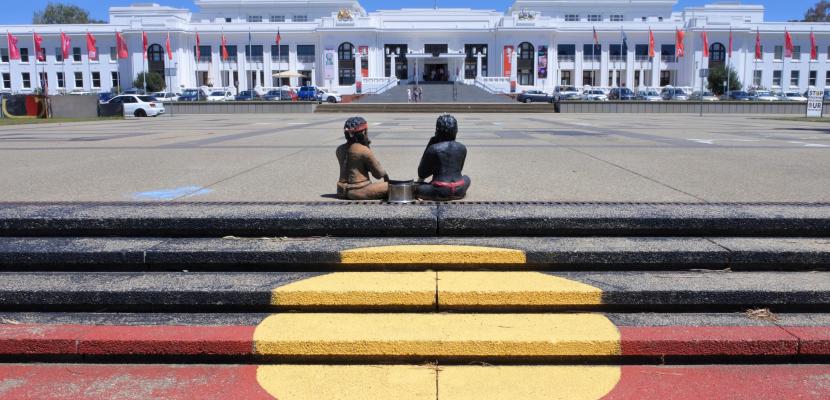
This article is by Assistant Professor of Aboriginal Health Kelly Menzel of Bond University and first appeared in The Conversation.
Over the past few weeks we have seen First Nations people protesting alongside alt-right “freedom” protesters at Old Parliament House in Canberra.
With this we saw a classic example of the alt-right trying to recruit disaffected marginalised people for their own ends.
This is not only dangerous given what we know about the history of First Nations peoples’ interactions with police, it also perpetuates a stereotype of First Nations people that we are dysfunctional, disunited and do not know what we want.
White supremacy and the Aboriginal Tent Embassy
The Aboriginal Tent Embassy in Canberra was established in 1972. The Embassy is a permanent, heritage-listed protest site representing the political rights of the Indigenous Peoples of Australia. It is the longest living Indigenous protest site in the world.
However, in recent months a clash of extremist white protesters alongside some Indigenous people, attempted a hostile invasion of the site in a bid to co-opt the Embassy’s cause. The group that descended the area included key white supremacist figures, including members of the Proud Boys.
These alt-right, extremist invaders are aligned with the global Sovereign Citizens (SovCits) movement, whose roots are racist and antisemitic. Sovereign Citizens are anti-government and believe they are sovereign from the laws of the country where they live.
These extremists misappropriated the long-term struggle of First Nations people, and created chaos and division.
It seems these groups find ways to recruit others by tapping into the distrust of authority. They potentially exploited this to recruit Indigenous people to an alt-right cause.
The presence of Indigenous people in these protests further perpetuates the narrative we are dysfunctional peoples who cannot agree - a stereotype white people as a collective do not have to worry about.
Indigenous people being perceived as dysfunctional springs from white deficit narratives about Indigenous communities. This deficit discourse represents our people in terms of incivility, discord and failure.
So whose sovereignty is really being fought for?
Sovereignty is one of the foundational principles of international law. Unfortunately, sovereignty under traditional Western Euro-centric international law was purposefully designed and restricted to what are considered “civilised” nations and Indigenous Peoples were (and one could argue still are) “objects” under the law.
Indigenous Sovereignty remains a separate concept and means something entirely different but is marginalised to Indigenous politics. It remains marginalised because of the history of Terra Nullius being applied to justify colonisation and the refusal of contemporary politicians to advocate on the issue. Indigenous Sovereignty has deep significance in the fight for recognition, and there are many models of what Indigenous Sovereignty looks like.
However, sovereignty cannot simply exist, it can only be asserted, claimed, or taken - which is the antithesis of Indigenous law and lore.
Sovereignty and the assertion of sovereignty is a critical item of Indigenous activism in Australia – the only commonwealth country without an agreement between Indigenous and non-Indigenous peoples. Terra Nullius was enacted in Australia because the colonial invaders believed the Indigenous Peoples were uncivilised and thus did not possess sovereignty, therefore did not have the right to exclude the invaders from their lands. Therefore, the notion of Indigenous Sovereignty is intertwined with the activism for Treaty and the pursuit of self-determination.
Sovereignty however, has been hijacked by the alt-right and their version of sovereignty is about the rights of (white) individuals to do what they like without the subordination of the outside authorities.
How does this impact Indigenous people?
White protesters co-opting Indigenous causes for their own “sovereignty” agenda is problematic in a number of ways.
First Nations people are often expected to educate those around us, and to freely give emotional and cultural labour. Providing such labour when educating about systemic violence while concurrently facing disadvantage due to white privilege in systems takes a significant toll. However, speaking out and protesting has very real life and death consequences for Indigenous People that white people do not need to consider.
First Nations People in Australia are the most criminalised and incarcerated in the world, and are at a higher risk of dying in custody.
White people also do not need to manage the same burdens, cultural loads or responsibilities, such as being asked to be the representative of their entire race. Nor are they collectively condemned when one white person does something that is considered “wrong”.
The far-right appropriating Indigenous causes is not new and often used to justify acts of violence. The far-right appropriate language about “rights” and twist them to fuel their own propaganda. This has been an effective tool to recruit all sorts of disenfranchised people.
In order to stop the momentum of these groups and their toxic way of thinking, we must ensure white people are no longer ignorant of the power of white privilege and the effect dysfunctionality speech, deficit narratives and systemic racism have on Indigenous Peoples and communities.
Many people may feel we are living in uncertain times, and these protest groups might try to pretend they have the answers people seek. But they do not. These groups encourage a pattern of ignorance that maintains social inequity for marginalised groups.
Instead these groups fuel hate speech, create further division in communities, and do nothing to bring stability to uncertain times.